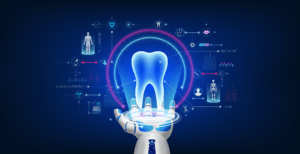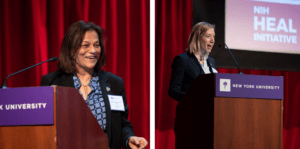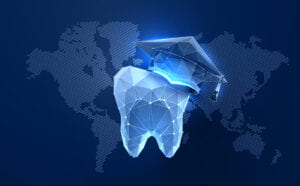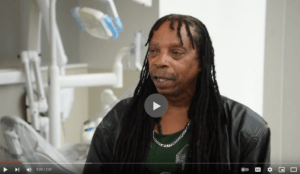
By Rick Valachovic, DMD, MPH, Clinical Professor and Director of the NYU Dentistry Center for Oral Health Policy and Management
If historical patterns are any guide, 2023’s dental school graduates will still be practicing dentistry in 2063. A lot will change in 40 years, and on the surface, that’s nothing new, but the pace of change is accelerating at an unprecedented rate. Just look at what’s happened in the last six months following the release and widespread adoption of ChatGPT and other “large language models” that use generative AI.
Just what is generative AI? Artificial intelligence (AI) — computer neural networks that mimic the human brain — have been with us for some time. If you talk to Alexa, wear a Fitbit, or use Google to search the web, you’ve already experienced the power of this technology.
Generative AI
Generative AI goes a giant step further, ingesting vast quantities of data, decoding its patterns, and then using these to create or generate writing, images, and even computer code that is potentially indistinguishable from what humans produce. Researchers are also putting these tools to use to model proteins; and while compliance regulations may keep change in check for the moment, the financial services sector is poised to employ this technology in the years ahead.
Business leaders are understandably concerned about AI’s ability to disrupt markets and increase cyber threats and reputational risk. American consumers have concerns, too. A Pew Research Center survey released in March found Americans’ excitement about the potential benefits of AI was tempered by a range of concerns. These included the loss of human jobs; surveillance, hacking, and digital privacy; a lack of human connection; and fear that AI will become too powerful, “outsmarting people.”
Lawmakers on the Senate Judiciary subcommittee are concerned, too. They are debating how to regulate a technology they barely understand before its influence on society, and on elections in particular, rivals that of social media. Testifying on May 16, Sam Altman, CEO of the company that developed ChatGPT, said generative AI’s potential to sway voters is “one of my areas of greatest concerns — the more general capability of these models to manipulate, to persuade, to provide sort of one-on-one disinformation.” Unlike some tech entrepreneurs previously called before the committee, Altman endorsed regulation of his industry.
Can Higher Education Adapt?
In higher education, a lot of discussion has focused on how this technology could undermine the status quo and challenge our ability to assess student learning. TurnItIn, well known for its software that detects plagiarism, now offers a solution designed to identify AI-generated text as well. These are valid concerns, but the bigger challenge before us is to prepare our students to practice in a world where ongoing change will be a constant.
I was president and CEO of the American Dental Education Association (ADEA) in 2018 when we devoted the annual meeting of the ADEA Council of Deans to the technological challenges facing dental schools. What we learned about innovations in clinical care, as one participant put it, was “absolutely breathtaking.” AI took up a good part of the day’s discussion, but so did robotics, miniaturization, biomaterials, and manufacturing techniques. I left the meeting awe struck by the range of new technologies at our disposal that can improve clinical care and ultimately patient outcomes.
That said, as a dental educator, I also left with concerns that have only increased in recent months. How do we prepare our students for an evolving clinical environment while also teaching them to function in the world as it currently exists? I don’t have the answer, but I’ve been pondering the question almost daily as stories of AI’s growing abilities appear in my news feed.
Seeking Answers
I asked ChatGPT how dentistry will be practiced in 2063. While cautioning that its “predictions are speculative,” the chatbot provided a list of current trends with the potential to shape future dental practice. These included advanced diagnostic tools, personalized treatment plans, improved implant technology, less invasive procedures, regenerative dentistry, and the use of nanotechnology, genetic testing, robotics, remote monitoring, and of course, AI. I would have come up with a similar list myself, but I expect these trends to become the norm by 2033, not 2063.
When I asked how AI specifically is expected to change dental practice, ChatGPT mentioned its ability to analyze images “more accurately and efficiently than human dentists alone;” its ability to enhance preventive care by identifying patients at higher risk for oral diseases; its ability to engage and monitor patients remotely using AI-powered chatbots and sensors; and its ability to accelerate research by analyzing vast quantities of data. Intriguingly, it also offered an opinion of on these developments. This won’t surprise readers who have followed discussions about bias in algorithms, the mathematical formulas that underly the computer code that powers AI.
ChatGPT’s answers to my questions were biased in favor of established professional norms. The text it provided me concluded: “It’s important to note that while AI offers promising advancements, it does not replace the role of dental professionals. Dentists will continue to play a critical role in treatment decision-making, patient communication, and overall oral health management. AI should be seen as a complementary tool to augment their expertise and enhance the quality of dental care.”
I suspect most readers will find this coda reassuring, while others will see these views as stymying change. Either way, as the internet becomes populated with more misinformation and disinformation, some of it created with the help of powerful AI tools, ChatGPT and its counterparts may express views that today would be considered far outside the norm. Our graduates will be practicing in this brave new world where ChatGPT is just the tip of the iceberg.
So how can we prepare them for this uncertain future? At NYU Dentistry, we’ve emphasized the importance of knowing how to evaluate scientific evidence to keep practice current. This focus remains essential, but as the COVID-19 pandemic showed us, the abilities to act in accordance with clearly defined values, weigh competing interests, and communicate effectively — in short, to lead — are equally important. That’s why we’ve introduced a portfolio of electives focused on character-based leadership to our DDS program.
I hope other dental schools will follow suit. It’s no longer enough to prepare our students to be competent clinicians in the here and now. A lot can happen in 40 years. We must prepare them to adapt to whatever comes their way.





